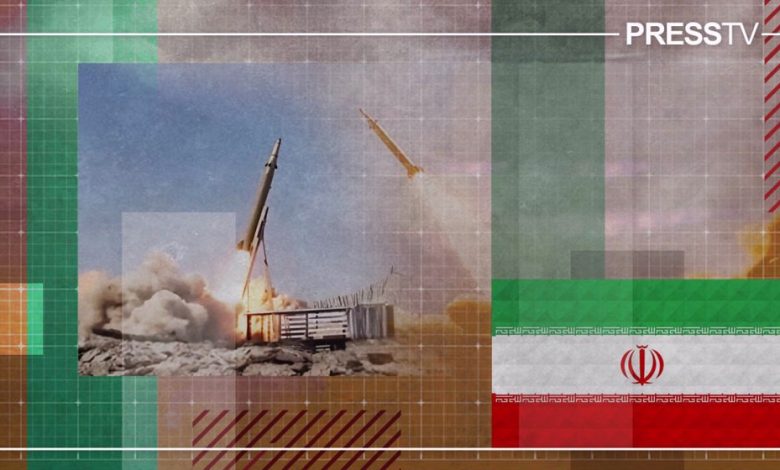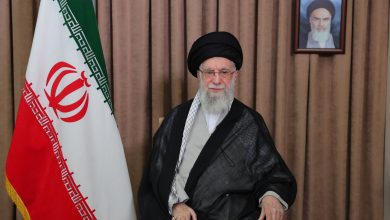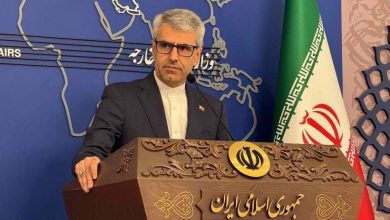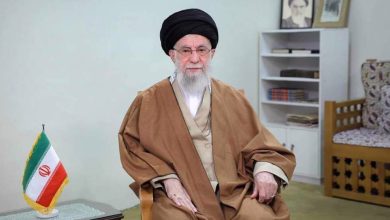Iran’s Qasem Basir Missile Emerges as Strategic Military Asset
On Sunday, Iran publicly introduced its newest missile, the Qasem Basir, a solid-fuel ballistic missile that boasts a 1,200-kilometer range and has recently undergone successful testing.

The newly unveiled missile represents an enhanced iteration of the Haj Qasem missile, which has been deployed in operational service for the past five years.
Iran’s Defense Minister, General Aziz Nasirzadeh, announced via state broadcaster that the missile has undergone significant improvements, particularly in guidance and maneuverability, surpassing its predecessors.
He also highlighted that Qasem Basir will be impervious to the United States’ THAAD and Patriot air defense systems, in addition to Israel’s multi-tiered Arrow defense systems.
Iranian state television broadcast footage of a ballistic test, reportedly conducted on April 17, showcasing the launch of Qasem Basir and its precise strike on a predetermined target in a natural environment.
Nasirzadeh reported that throughout the testing phase, the missile was subjected to significant electronic interference, yet it demonstrated resilience and remained unaffected.
Reports indicate that the missile boasts enhanced maneuverability, a capability developed from insights gained during the two retaliatory operations conducted last year, True Promise 1 and 2, targeting the Zionist regime.
The predecessor of Qasem Soleimani, the influential Iranian military leader, was Ahmad Vahidi, who served as the commander of the Quds Force prior to Soleimani’s appointment to the position in 1998.
The Haj Qasem is a two-stage tactical missile featuring solid-fuel technology and characterized as quasi-ballistic. It was introduced in August 2020 and named in honor of the late Iranian commander Qasem Soleimani.
The missile possesses a total mass of 7 tons, with a warhead weighing 500 kilograms, and spans a length of 11 meters. Upon atmospheric entry, it achieves a speed of Mach 11, while its impact speed is recorded at Mach 5, categorizing it within the hypersonic range.
Iran’s Haj Qasem missile has a reported range of 1,400 kilometers. At the time of its unveiling, officials indicated that the missile could be designed to extend its range to 1,800 kilometers.
In 2023, at the Defense Achievements Exhibition attended by the late Ebrahim Raisi, a novel capability of the Haj Qasem missile was showcased, marking a significant reduction in its preparation and launch time over previous systems.
The enhancement originated from adjustments to the missile’s platform structure, enabling significantly quicker readiness and launch capabilities compared to previous models.
According to experts, the missile system is thought to utilize Dynamic Reference Unit (DRU) technology. This advanced capability offers real-time, high-precision orientation data, including parameters like pitch, roll, and yaw. It achieves this by integrating accelerometers, gyroscopes, and occasionally magnetometers.
With the assistance of this system, a transporter erector launcher (TEL) is capable of initiating a launch immediately after being deployed and erected, allowing it to swiftly fold and exit the launch site thereafter.
The Kheibar Shekan and Fateh missile systems have also integrated this cutting-edge technology, which, as reported by Brigadier General Amir Ali Hajizadeh, significantly reduces preparation time to just one-sixth of that required by other missile systems.
Qasem Basir presents a range of enhancements designed to optimize efficiency and performance in his field. His proposals include streamlining processes, implementing innovative solutions, and fostering collaboration to drive progress and achieve strategic objectives.
According to statements from military officials and analysis of launch footage, the Qasem Basir missile exhibits numerous similarities to the Haj Qasem in both dimensions and capabilities, and employs the identical launch platform.
Both missile systems are equipped with eight stabilization fins located at the rear section and do not include thrust vector control, a component found in other Iranian missile platforms. Despite this absence, they maintain adequate maneuverability capabilities through the use of aerodynamic control surfaces and trajectory fine-tuning in the final phase of flight.
There are distinct differences between Qasem Basir and Haj Qasem in terms of warhead enhancements, particularly concerning the guidance systems and maneuverability capabilities.
Iran’s ballistic missiles, such as the Haj Qasem, predominantly rely on a combination of the Global Positioning System (GPS) and an inertial navigation system (INS) for navigation.
The missile operates by utilizing GPS data during its initial and mid-course trajectory, eventually switching to an Inertial Navigation System (INS) for guidance in the terminal phase.
The rationale behind this is that GPS systems are susceptible to interference from electronic warfare (EW) operations. Adversaries are anticipated to employ a range of EW techniques to disturb missile guidance systems, thereby diverting ballistic missiles and inducing inaccuracies in their targeting objectives.
In contrast, the Inertial Navigation System (INS) employs multiple gyroscopes and accelerometers that play a crucial role in directing the missile to its intended target. These instruments calculate angular velocity and ensure the missile remains on its designated path, preventing any deviation.
The INS-guided missile adjusts its trajectory considering physical and atmospheric factors, but its accuracy diminishes in the final phase of movement due to its high speed, when compared to GPS-guided systems.
The Qasem Basir missile has been equipped with optical guidance technology, a development driven by experience in anti-Israeli operations that underscores the necessity for high-precision strikes on targets such as hangars. This advancement also ensures the missile’s resilience to electronic jamming, enhancing its operational effectiveness.
Optical guidance systems, particularly thermal imaging cameras, enhance targeting precision considerably and demonstrate resilience against electronic warfare and external jamming efforts.
A constraint of this guidance strategy is its impact on diminishing the missile’s range, contributing to the decreased reach of the Qasem Basir missile relative to that of the Haj Qasem missile.
The Qasem Basir missile, despite a reduction of 200 kilometers in its range, remains capable of reaching the territories considered occupied within Palestine.
Optical guidance systems have been utilized in earlier iterations of Iranian short-range ballistic missiles; however, these missiles typically boasted a significantly shorter range of approximately 300 to 500 kilometers, which is notably less compared to Qasem Basir.
The newly developed missile possesses advanced guidance systems, enabling it to accurately strike highly selective targets, including hangar entrances and even mobile vessels on the sea.
A newly released video showcasing a test of the Qasem Basir missile reveals remarkable precision, as the missile successfully strikes the center of a marked square target. This demonstration implies that the missile’s accuracy is gauged in decimeters rather than meters.
The Qasem Basir missile’s newly introduced feature is its enhanced warhead maneuverability. This advancement is crucial, as global air defense systems find themselves vulnerable against missiles capable of altering their trajectory at supersonic or hypersonic speeds.







